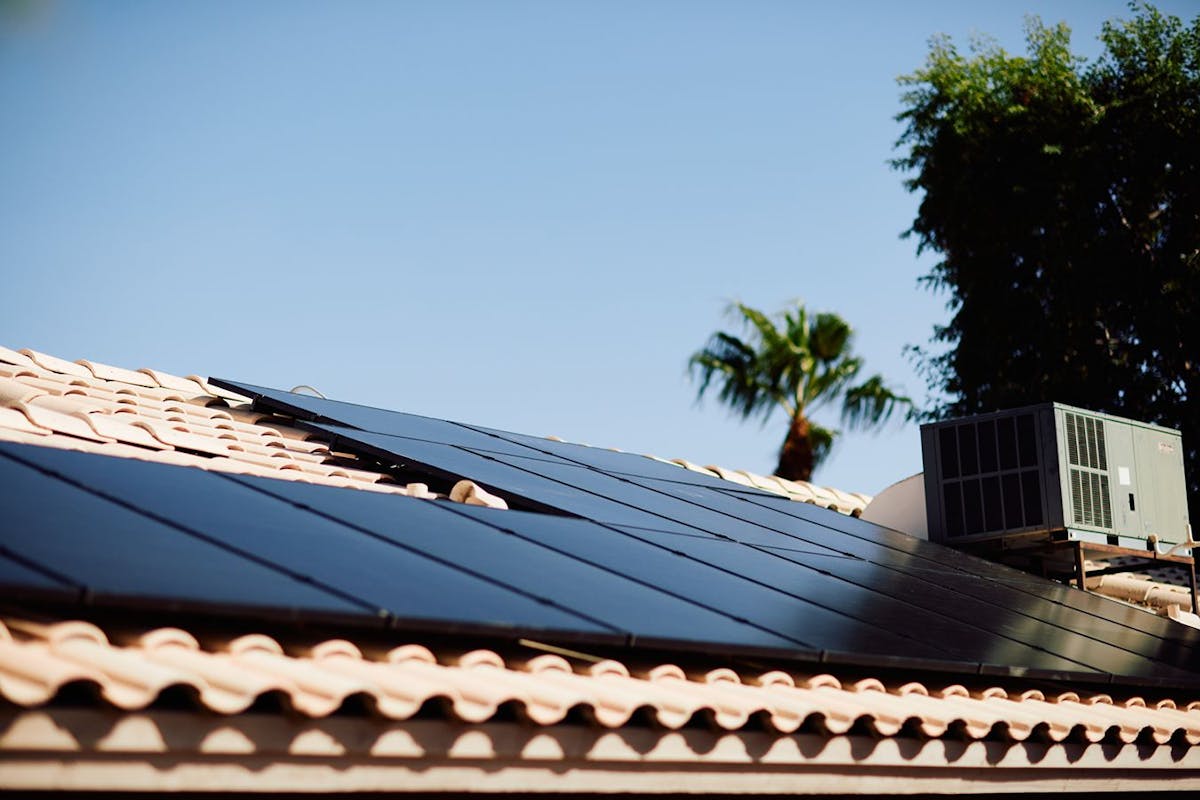Charging an Electric Vehicle With Solar Panels: How Many Panels Do You Need?
Last edited

Author
Andrew Giermak
Solar and Electrification Writer and Editor

Editor
Andrew Blok
Electrification and Solar Writer and Editor

More people have home solar panels than ever before. More people are driving electric vehicles than ever, too. When you combine the two, you can get the most savings while using the cleanest energy.
In this guide to charging an EV with energy from solar panels, we’ll look at how much energy and time it takes to charge an EV, and how battery capacity, battery range, and charger levels affect both.
See how much you can save by going solar with Palmetto
What Is an Electric Vehicle?
An electric vehicle (EV) is a car, truck, or SUV that uses one or more electric motors and energy stored in a battery, instead of an internal combustion engine that runs off of gas or diesel.
Sometimes certain hybrid vehicles are lumped in with fully electric vehicles. For this article, we will focus on 100% electric vehicles, meaning they are plugged into an electrical outlet to be charged.
How Much Energy Is Needed to Charge an EV?
The battery rating of an electric vehicle indicates the amount of power that it can store, which indicates how much power is required to fully charge it. This is typically measured in kilowatt-hours, or kWh. We’ve outlined common EV battery sizes below:
- Rivian R1T - 105 kWh; 135 kWh; 180 kWh
- Audi e-tron - 95 kWh
- Tesla Model S - 100 kWh
- Tesla Model X - 100 kWh
- Tesla Model Y - 75 kWh
- Tesla Model 3 - 54 kWh; 82 kWh
- Chevrolet Bolt EV - 65 kWh
- Nissan Leaf - 40 kWh; 62kWh
- Ford Mustang Mach-E - 68 kWh; 88 kWh
How Long Does Electric Vehicle Charging Take?
The brand, make, and model of the vehicle and the at-home electric car charger all make a difference in the charge time for your electric vehicle.You also have to consider the battery level at the time charging begins, the total capacity of the battery, and if you’re charging the battery to full.
Two traditional home charging options use AC electricity: Level 1 and Level 2 electric vehicle home charging stations:
- Level 1 is a 120v charger, and it can charge at a maximum of 1.9 kW, which means they can add about 5 miles of range per hour of charging time. Since it’s a 120v system, you plug these into regular outlets, like any other device.
- Level 2 is a 240v charger, and it can charge at a maximum of 19.2 kW, which means they can add about 25 miles of range per hour of charging time. Because it’s a 240v system, you need a special outlet, similar to what’s used for clothes dryers, ranges, and other large appliances.
While Level 3 fast-charging options like the Tesla Supercharger use DC electricity and can add nearly 200 miles of range per hour of charging time, these chargers are primarily used in commercial settings, not residential, because of the amount and type of electricity they need, and the complexity of that charging technology.
Examples of electric vehicle charging times
To illustrate typical EV charging times, we’ve outlined the range for some of the most popular electric vehicles. The data below reflects the time it typically takes to fully charge a battery from empty for both types of electric car home charging stations, based on the average battery size for each vehicle:
120v Level 1 charger
- Rivian R1T - Up to 100 hours
- Audi e-tron - Up to 50 hours
- Tesla Model S - Up to 53 hours
- Tesla Model X - Up to 53 hours
- Tesla Model Y - Up to 40 hours
- Tesla Model 3 - Up to 44 hours
- Ford Mustang Mach-E - Up to 47 hours
- Chevrolet Bolt EV - Up to 35 hours
- Nissan Leaf - Up to 33 hours
240v Level 2 charger
- Rivian R1T - 5 to 10 hours
- Audi e-tron - Up to 5 hours
- Tesla Model S - Up to 6 hours
- Tesla Model X - Up to 6 hours
- Tesla Model Y - Up to 4 hours
- Tesla Model 3 - 3 to 5 hours
- Ford Mustang Mach-E - 3 to 5 hours
- Chevrolet Bolt EV - Up to 4 hours
- Nissan Leaf - 2 to 4 hours
Actual charging times for electric car charging at home may vary based on several factors including optional upgrades to the battery, charging conditions, and the vehicle’s driving range. Also, for the Level 2 charging specs, the time provided is based on the maximum power output of a Level 2 charger, but the actual output of the charger that comes with the vehicle may be less, which decreases the charge speed.
While the charging times may seem high, it’s important to note that EV owners usually do not charge from a completely dead battery to a completely full one, as it's more common to charge in stages. If you only drive a few miles each day, an overnight charge on a Level 1 charger with a lower charge rate may be enough to keep your batteries topped off and ready to go.
How Many Solar Panels Does it Take to Charge an Electric Vehicle?
To calculate the number of solar panels you’ll need to charge your EV, you need to look at your daily driving patterns. Roughly speaking, the more you drive every day, the more power you’ll need to recharge the battery to full again. In reality, most people only replenish what they need to make their daily commute and a little bit more for errands around town.
Before the pandemic, the Federal Highway Administration calculated the average number of miles driven to be a little over 14,000 miles per year or around 40 miles per day. We'll use this number for our example.
To begin, let's look at how much electricity our sample cars use for every 10 miles driven, according to the Environmental Protection Agency's fuel economy estimates:
- Tesla Model 3 - 2.4 kWh
- Tesla Model Y - 2.6 kWh
- Tesla Model S - 2.8 kWh
- Chevrolet Bolt EV - 2.9 kWh
- Nissan Leaf - 3.0 kWh
- Tesla Model X - 3.2 kWh
- Ford Mustang Mach-E - 3.3 kWh
- Audi e-tron - 4.3 kWh
- Rivian R1T - 4.8 kWh
We'll walk through the low and high calculations to give an example: Tesla Model 3 at 2.4 kWh/10 miles and Rivian R1T at 4.8 kWh/10 miles, respectively.
To begin, multiply each by 4 to get our 40-mile commute:
- Tesla Model 3: 2.4 kWh/10 miles * 4 = 9.6 kilowatt-hours of electricity used per day
- Rivian R1T: 4.8 kWh/10 miles * 4 = 19.2 kilowatt-hours of electricity used per day
Next, divide the kilowatt-hours used by the number of peak sun hours your solar panels will receive. This gives you the number of kilowatts needed to recharge your battery. For this example, we’ll assume you live in an area with an average of 7 peak sun hours per day.
- Tesla Model 3: 9.6 kWh / 7 hours = 1.37 kilowatts
- Rivian R1T: 19.2 kWh / 7 hours = 2.74 kilowatts
Finally, divide the number of kilowatts needed to recharge your battery by the panel rating on your solar array. We’ll use 350 watts as our example solar panel rating:
- Tesla Model 3: 1.37 kilowatts / 350 watts per panel = 3.9 or 4 panels
- Rivian R1T: 2.74 kilowatts / 350 watts per panel = 7.8 or 8 panels
As you can see, the average EVis going to need 4-8 solar panels to recharge on a day with ideal conditions.
See how much you can save by going solar with Palmetto
What to Know if You Have Solar Panels and Want to Buy an EV
If you have home solar panels, you probably understand the relationship between your daily electricity generation and consumption. When considering the addition of an EV, you have to factor in the additional charging needs of the vehicle. You may need to add more solar panels to charge an EV, to offset the increased amount of electricity your home will use if you want to avoid using extra electricity from the grid.
The formulas outlined above can help you estimate how many solar panels you'll need to add to power your electric vehicle home charger, so you can then determine how much it will cost to have them installed.
Here are a few other factors to consider:
- Timing: It takes time to get approval for new solar panels and have them installed. Does this timeline line up with your timeline for purchasing a new electric vehicle?
- Roof space: If you want to charge your electric vehicle with clean, solar energy, you’ll need enough roof space available to expand your solar array to account for the new electricity demand. Here’s our guide to calculating the necessary roof space for the panels you’ll want to add.
- Battery storage: Electric vehicle chargers can use a lot of electricity. Unfortunately, many people drive their car to work during the day, which means it’s not plugged in and charging during the hours when solar panels are most productive. If you want to only use solar energy to charge your EV, you should consider installing solar batteries for your home. That way, you can store any excess energy your panels generate during the day and then use that power to charge your vehicle at night.
- Home charger: If you’re planning to charge your electric car at home, you need to consider the cost of the charging device and charging cable, its location (wall-mounted or on a pole), installation fees (including electrical panel upgrades if needed), and other logistical factors into the overall cost.
What to Know if You Have an EV and Are Going Solar
To determine how many solar panels you'll need to have installed, you should first calculate how much electricity your family uses on average each day, and add charging an EV. You should also account for any future plans, and how they’ll affect your consumption. If you know you want to grow your family, expand the footprint of your house, or start working from home, you may want to opt for additional panels upfront to account for those future needs.
Beyond usage, there are other factors to consider:
- Roof: The type and size of your roof will play a role in determining whether you can install solar panels, how much light they'll have access to, and how many will fit.
- Peak sun hours: Every area receives a different amount of average daily sunlight. A professional solar provider like Palmetto will have specific data of the sunlight your home receives, and the optimal number of panels your system will need.
- Weather: Obviously, local weather patterns impact sunlight on your solar panels, but your panels can still generate electricity on cloudy days. Your solar panel system installer can calculate the number of panels you need to power your home, based on historic weather patterns.
Solar Panels, Solar Battery Storage, and Electric Vehicles
When thinking about your EV, solar panels, and battery storage working together, you should first consider how you plan to use your EV. If you work away from home during daylight hours, the car can't be plugged in and charging at home, so you may want to consider a solar storage battery. Without a battery to store the solar energy produced during the day, the energy you use to charge your EV at night will come from your utility, and will likely be sourced from fossil fuels.
However, if net metering is available in your area, your utility company credits your account for the excess solar power you send back to the electricity grid during the day. You can then use those credits at night to offset the cost of charging your EV when the solar panels aren't producing electricity.
If you live in an area with time-of-use (TOU) rates, you can use smart chargers to charge your electric vehicle when the rates are lowest. This smart-charging feature is built into some EVs, while others can accomplish the same goal with an EV charger upgrade.
Rebates and Incentives for Charging an EV with Solar Energy
The federal government has a program designed to make it more affordable to switch to clean energy. With the solar tax credit, you may be eligible to claim a portion of your solar installation costs as a credit on your federal taxes. This program can lead to significant savings. Tax credits for EVs and EV chargers are available, too.
Because many programs designed to incentivize EVs and solar energy are done at the state or local level, the exact programs available to you depend on where you live. The Database of State Incentives for Renewables & Efficiency (DSIRE) maintains a list of these incentives that can be searched by location.
The Future of Solar Power and Electric Vehicles
Electric vehicle manufacturers like Jeep and Rivian have started initiatives to bring solar charging stations out onto the adventure trail. Being unshackled from gas stations will allow adventurers to stay off the beaten path longer.
One automotive manufacturer wants to merge solar power and EVs as much as possible. Aptera Motors is producing an EV with an integrated solar panel, and the company claims their futuristic-looking car will require no charging for most daily use.
If you want something more traditional, Sono Motors also has a vehicle with built-in solar modules. Even established car companies like Hyundai are driving new solar technologies like a solar panel roof that can help charge the battery pack and power the heating and air conditioning.
Solar Power and EV Shopping Guide
While there are commercial charging stations for those who need energy on long road trips, home charging stations can free EV owners from the hassle of frequent stops at a charging station.
With a well-thought-out solar installation, EV drivers can also be freed from the expensive energy bills that could come from charging their vehicle. As EV manufacturers continue to join forces with solar power companies, we'll see exciting new developments.
If you’re considering an electric vehicle and a solar energy system for your home, it’s important to account for the charging needs of your EV when calculating the solar system’s size and possibly including battery storage.
To learn more about going solar and charging your EV with clean, renewable energy, get started today with a free solar design and savings estimate from Palmetto.
See what solar can do for you:
Frequently Asked Questions
How long does it take to charge an EV with a home charger?
It can take anywhere from less than an hour up to 100 hours depending on the vehicle, the battery level when you begin charging, the charger and charger level, and if you need to fully charge the vehicle.
Can I still charge an EV without having a solar storage battery?
Yes, if you don’t have a battery storage system, you can charge a vehicle using solar power as it’s being generated or with grid electricity when you have no or low solar power.
Disclaimer: This content is for educational purposes only. Palmetto does not provide tax, legal, or accounting advice. Please consult your own tax, legal, and accounting advisors.


